The bass Xylophone can be a fantastic first musical instrument. Many music educators use these wonderful instruments in their classrooms to add a touch of magic to their students’ musical journey.
If you are in the market for the best Bass Xylophone you can find, this comprehensive guide will help you discover the pros and cons of the different brands on the market!
What to Look For in Buying a Bass Xylophone
1. Make sure it’s actually a bass xylophone!
One of the first things to look for when buying a Bass Xylophone is that what you are looking at is actually a Bass Xylophone. When looking for a Bass Xylophone, you will see instruments similar to those above that are not Bass Xylophones.
Note: There are Alto Xylophones, Tenor-Alto Xylophones, and Soprano Xylophones. If buying online, search for “Bass Xylophone,” and some variations may pop up. Check the listing to see if it is a Bass Xylophone or has the word Diatonic in the title.
2. What are the bars made of?
The second feature to look for when buying a Bass Xylophone is what the bars are made of. Remember, xylophones do not have metal bars. A Bass Xylophone will have bars made of cocobolo, padauk, pao rosa, rosewood, or a mix of synthetic materials like fiberglass and fiberglass-reinforced plastic.
The resonator box material you should look for is also essential, along with the bar material. The ideal resonator box material is birch or pine. Birch and pine are incredibly stable and durable kinds of wood, and they can withstand years of use by children.
3. How many bars does it have?
The number of bars is essential when looking for a good Bass Xylophone to purchase. A Bass Xylophone will have 13 bars and should come with three extra bars that can be attached to the resonator box.
A Bass Xylophone should come with two F# bars and a single Bb bar, which can be used to extend the range of the xylophone to make the C major scale into a chromatic scale.
4. What is the price?
The final thing to consider when purchasing a Bass Xylophone is the price. While Bass Xylophones are used in elementary music classes, they are still instruments and are not cheap. If you have a budget, finding the xylophone that fits your budget is important.
What Brands and Models are the Best?
The following brands and models of Bass Xylophones are not listed in any particular order, and all of the xylophones listed below are excellent choices across a range of prices.
Suzuki Bass Xylophone with Mallets Standard
The Suzuki Bass Xylophone with Mallets Standard is an excellent option if you want to purchase a Bass Xylophone. The bars on this instrument are made of genuine rosewood, which enhances the timbre and the warm-sounding tone that xylophones are known for.
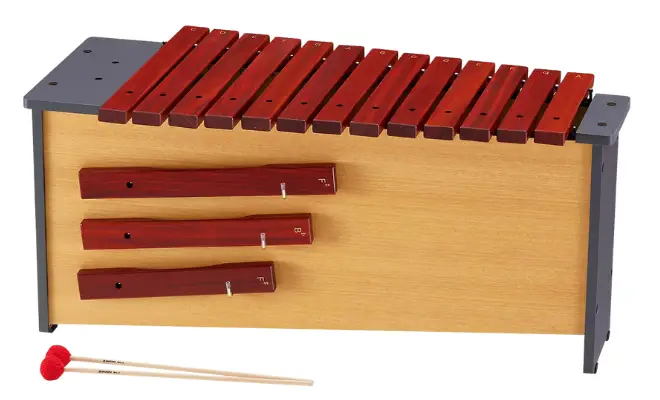
This Bass Xylophone is equipped with:
- It has a chromatic bar storage on the side of the resonator box
- It comes with one Bb and two F# bars.
- The bars have the note names engraved onto the top of the bars to help a musician learn notes without the pressure of memorizing all 13 bars and their order. Inside the resonator chambers, the note names are printed as well.
- The Suzuki Bass Xylophone comes with two pairs of mallets that are appropriate for this xylophone, and there is mallet storage built into the instrument.
- One perk of this Bass Xylophone is that the tubing on the rim of the resonator box is made with “Indestructible cloth-covered Orff instrument tubing.”
Sonor Orff GBX-GBF Global Beat Bass Xylophone
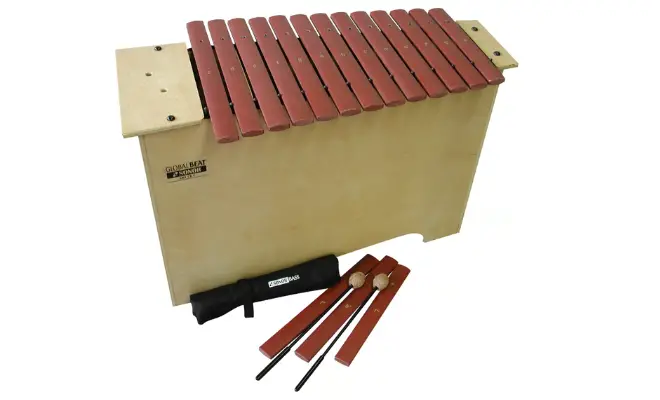
The Sonor Orff GBX-GBF Global Beat Bass Xylophone is made with fiberglass bars that look like rosewood. The resonator box has six resonance chambers and is made of high-quality birch plywood that can withstand years of use with musicians of any age.
- Each of the 16 bars has been stamped with the note name on them so players can better internalize the sound of the notes and associate them with their name.
- This Bass Xylophone comes with three additional bars, two F#, and one Bb bar to extend the range of the instrument.
- A pair of appropriate mallets come with each Sonor Orff GBX-GBF Global Beat Bass Xylophone.
Primary Sonor GBXP1 Diatonic Deep Bass Xylophone Standard
While all Sonor instruments are exceptionally made, the Primary line of Orff instruments has been specifically designed to enhance the sound quality of Sonor instruments while being durable and affordable. This Bass Xylophone is built in Sonor’s German workshop and uses the best materials.
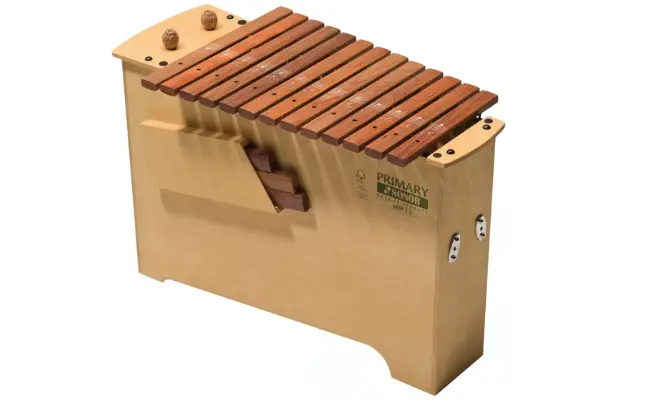
Note: This Bass Xylophone is unique because it comes with brackets for leg or stand attachment and flexible rubber pins for placing the bars when adding or removing the additional three bars that come with this instrument.
- The bars on this Bass Xylophone are made with high-quality African rosewood, and the note names are printed on the center of all 16 bars.
- The resonator box is 100% birch wood, and the seams are glued together, which enhances the resonance and clarity of this Bass Xylophone.
- There is a built-in bar and mallet storage, and the bars all measure 33 x 18mm. A pair of appropriate mallets come with the instrument.
Studio 49 Series 2000 (BX 2000) Bass Xylophone
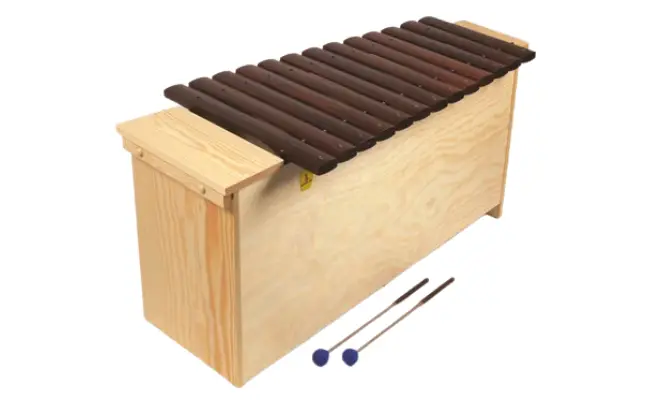
The Studio 49 Series 2000 Bass Xylophone offers “optimal quality and best overall sound.” Studio 49 classifies its 2000 Series of xylophones as Premium, and the bar material, Amazon Jacaranda rosewood, has been hand-picked and explicitly cured for the 2000 Series of xylophones.
This Bass Xylophone is based on Studio 49’s original BXd models and features harmonic fundamental and overtone tuning.
- The resonator box is made of solid pine with multiple chambers.
- This improved version uses both flexible and fixed pins to secure the bars.
- The Studio 49 Series 2000 (BX 2000) Bass Xylophone comes with a pair of wool-wrapped mallets.
- Studio 49 also offers a Series 2000 Bass Xylophone with specialty fiberglass or Grillodur bars if you are interested.
Studio 49 Series 1600 (BX 1600) Bass Xylophone
Introduced in 2006, the Studio 49 Series 1600 (BX 1600) Bass Xylophone is considered an “intermediate” instrument by the brand. This Bass Xylophone is ⅔ the size of the Series 2000 Bass Xylophones and weighs only 15 pounds, seven pounds lighter than the Series 2000 models.
The top of the resonator box is partially covered in order to produce the maximum amount of resonance for the lower bars. The Studio 49 Series 16000 Bass Xylophone’s bars are made from Pau Rosa, a very heavy and hard wood known for its stability and resistance to rot.
Another difference between the Series 16000 and the Series 2000 Bass Xylophones is that the Series 1600’s resonator box is made of solid pine with multiple chambers. This instrument comes with attached handles which makes it easier to carry by hand, two F# and one Bb bars, and a pair of appropriate mallets.
Studio 49 BX 1000 Bass Xylophone
The Studio 49 BX 1000 Bass Xylophone is part of Studio 49’s “compact line” of Studio 49 Orff instruments. This Bass Xylophone is similar in size and weight to the Series 1600 xylophones, but several differences exist.
The bars for this instrument are available in Pau Rosa or fiberglass with the note names stamped on the bars. Like the other two models of Studio 49 Bass Xylophones, the resonator box is made of solid pine.
It has multiple chambers, complementing the Pau Rosa bars and enhancing the overall sound projection. The xylophone comes with two F# bars and one Bb bar to extend the range of the instrument. However, there is no built-in bar storage like all Studio 49 Bass Xylophones.
The wool-wrapped mallets that are included with the Studio 49 BX 1000 Bass Xylophone do not have a grip, only the shaft and head. The lack of a grip allows students to learn where to place their hands on the mallets when holding them.
Comparison Chart
Name | Bar Material | Resonator Material | Mallets Included? | Built-in Bar/Mallet Storage | Price |
| Suzuki Bass Xylophone Standard | Rosewood | Not Listed | Yes | Yes | $729.99 |
| Sonor Orff GBX-GBF Global Beat Bass Xylophone | Fiberglass | Birch | Yes | No(Comes with a detached storage bag) | $815.00 |
| Primary Sonor GBXP1 Diatonic Deep Bass Xylophone | Rosewood | Birch | Yes | Yes | $1,365.00 |
| Studio 49 Series 2000 Bass Xylophone | Rosewood or Fiberglass | Pine | Yes | No | $2,275.00 |
| Studio 49 Series 1600 Bass Xylophone | Pau Rosa | Pine | Yes | No | $1,400.00 |
| Studio 49 BX 1000 Bass Xylophone | Pau Rosa or Fiberglass | Pine | Yes | No | Pau Rosa – $1,155.00Fiberglass –$1,130.00 |
The Bass Xylophone is a unique instrument that is used in two major approaches to music education.
The Orff Approach
The Bass Xylophone is used in Orff Schulwerk, more commonly called the Orff Approach, which is a developmental approach that music educators may use. The Orff Approach combines music, movement, speech, and drama into lessons that young children can learn while playing a game or imaginative play.
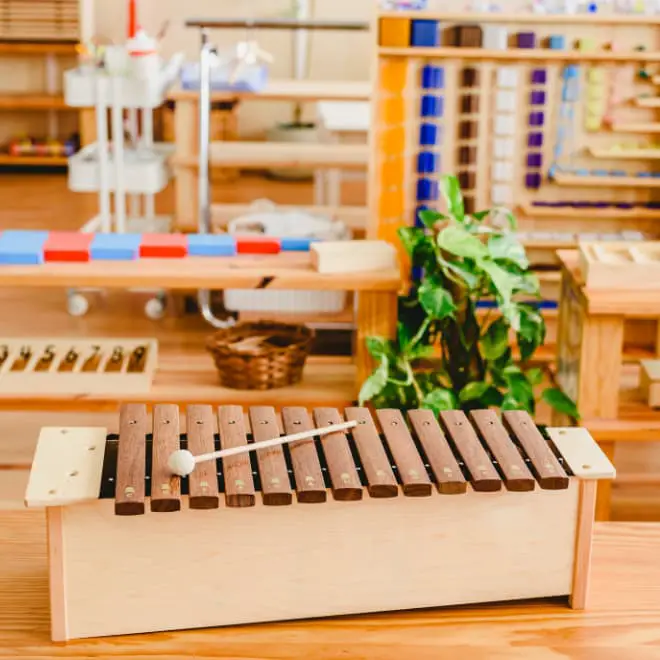

The Suzuki Method
The second method of music education that uses Bass Xylophones is the Suzuki method. The Suzuki method created an “environment for learning music which parallels the linguistic environment of acquiring a native language.” These methods are used in elementary music education, and you might have been introduced to music using either of these methods back in elementary school!
Beyond elementary music education, the Bass Xylophone is a unique instrument that is great to learn to play the xylophone with.
These are smaller and easier to handle than a standard xylophone. But what should you look for when trying to find the best Bass Xylophone to purchase? Keep reading to find out!
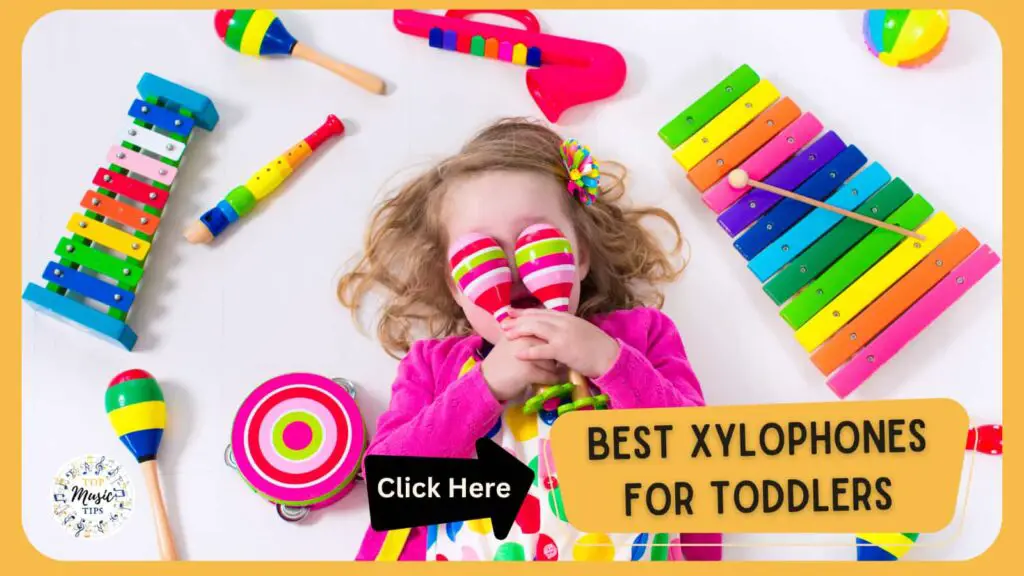
Bass Xylophone vs. Xylophone
While xylophones often are misidentified as a glockenspiel or a marimba, it is easy to identify the difference between a Bass Xylophone and a standard xylophone.
The Bass Xylophone is smaller than a standard xylophone. A regular xylophone has 44 bars and can span several octaves, while the Bass Xylophone has only 13 bars (usually comes with three bars that can be added or removed), and the range is that of a C major scale, C to A1. The size of a Bass Xylophone is much smaller than a standard xylophone.
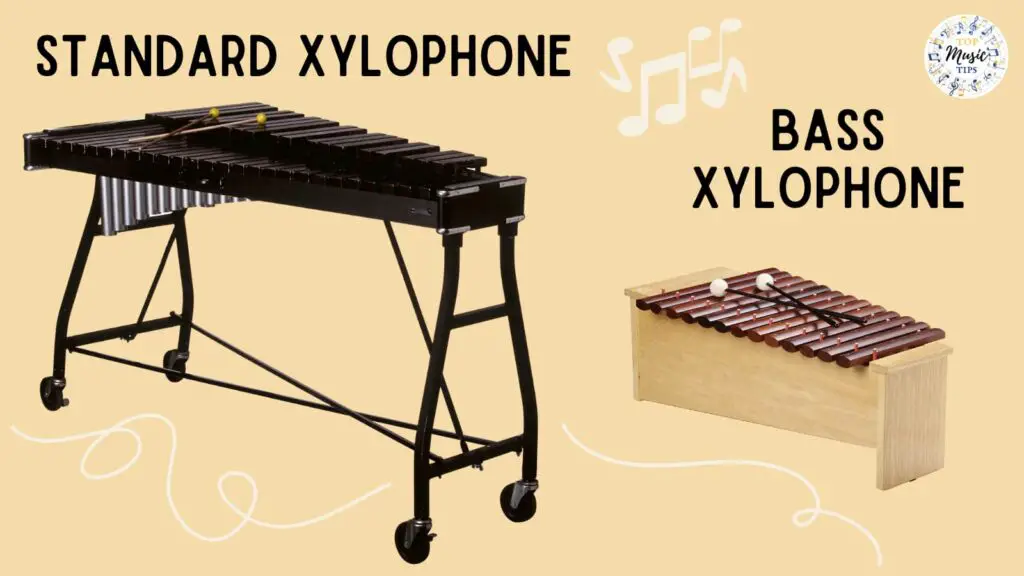
A Bass Xylophone can be placed on a table or directly on the ground, while a normal xylophone is built around a frame with wheels.
Another difference between the two xylophones is that while the standard xylophone has resonator bars under the bars that project and sustain the sound, a Bass Xylophone has a resonator box. These resonator boxes have between five and six chambers which act the same way a resonator bar does.
Bass Xylophones are relatively rare in an orchestra or concert band, and if a score calls for a Bass Xylophone and the band does not have one, a marimba is used instead. The sound of a Bass Xylophone is closest to a marimba regarding its dark and warm tone.
Bass Xylophones usually have the note name engraved into the bar, so it is easy to identify what notes to play. You might have played the Bass Xylophone in elementary school music classes. These are used because they are sturdy, easy to move, and store, and they are a suitable size for younger musicians because they can be played while sitting on the floor or standing at a table.
| Feature | Xylophone | Bass Xylophone |
|---|---|---|
| Size | Larger than Bass Xylophone | Smaller than standard xylophone |
| Number of Bars | 44 bars | 13 bars (can be expanded or reduced) |
| Range | Spans several octaves | C major scale, C to A1 |
| Placement | Built around a frame with wheels | Can be placed on a table or ground |
| Resonator | Resonator bars under the bars | Resonator box with chambers |
| Common Usage | Orchestras, concert bands | Elementary school music classes |
| Sound | Bright and vibrant | Dark and warm, similar to a marimba |
| Note Identification | No note names engraved on the bars | Note names engraved on the bars |
| Suitability | Suitable for older musicians, performances | Suitable for younger musicians, education |
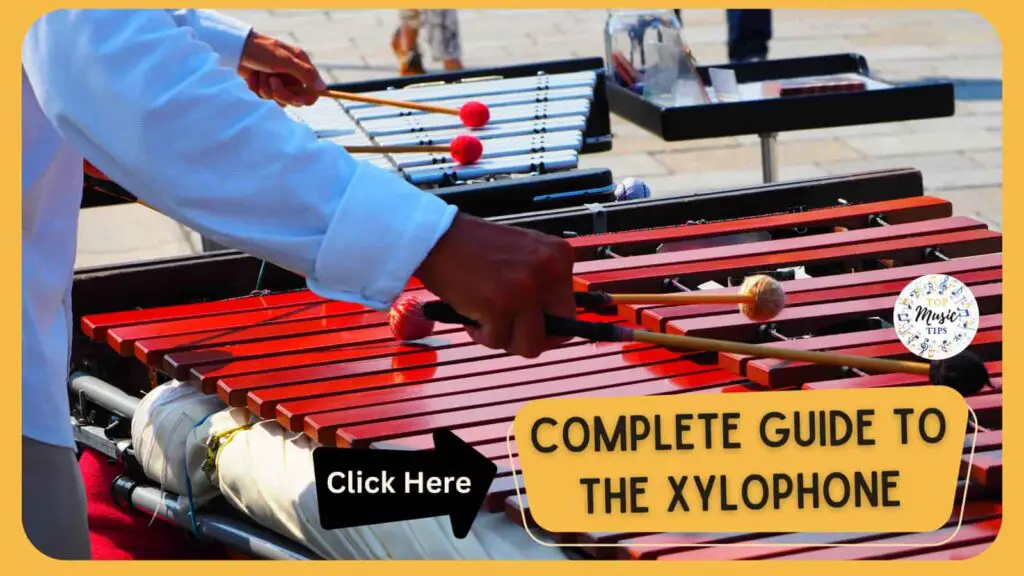
We hope this article has been helpful and informative for you in your musical journey. Please let us know if there is anything that we could add or change to make this article a better resource for our readers.
Please e-mail us at: [email protected] to let us know how we are doing!
Disclaimer: This post may contain affiliate links. We only recommend high-quality products that are used and recommended by real musicians. If you use these links to buy something we earn a small commission.
